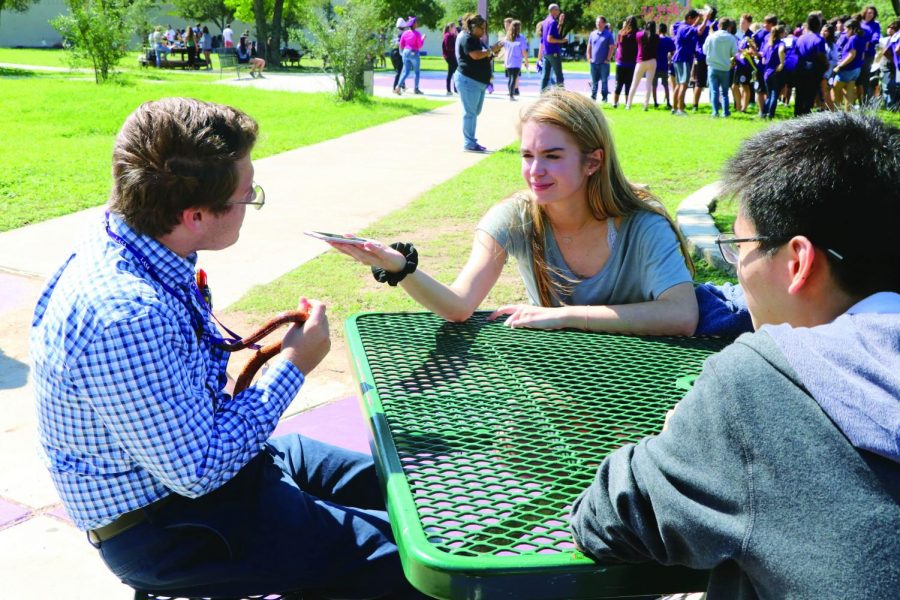Meet the humans of LASA
Senior Megan Gilbert interviews senior Johnathan Anstead for a feature on instagram @humansoflasa. She is one of several LASA students running the page, which has amassed over 300 followers. photo by Helena Lara
October 30, 2018
At the beginning of this summer, Humans of LASA made its debut Instagram post: a headshot of a LASA student. For some students, the sight of his face will stir recognition, while others have never seen him before. The photo’s caption contains a few paragraphs describing who the student is in his own words. His friends might know his story already. However, LASA has more than 1,200 students, so chances are most of the post’s viewers will learn something new about him.
Senior Megan Gilbert created the Humans of LASA Instagram account. At least once a month, Gilbert creates a post focusing on a specific LASA student, which can be seen by all other students who follow the account. She works with two of her peers, senior Kendrick Lam and senior Mateen Kontoravdis, to run the account. (Kontoravdis is an editor-in-chief of the Liberator.)
Gilbert said she thought of the idea for Humans of LASA over the summer while attending a University of Texas program focusing on global ethics and conflict resolution. During the program, she was asked to interview a fellow participant that she didn’t know very well.
“I was paired with someone named Kari, and I got to learn all about her—I hadn’t spoken to her at all before then,” Gilbert said. “I was amazed by how much she opened up to me, and it was just a really cool experience.”
Because of that activity, Gilbert was able to connect with a complete stranger and discover a lot about her, which she wouldn’t have been able to learn otherwise. She wanted Humans of LASA to do the same thing for LASA students that the program did for her and Kari.
“I thought it would be a cool thing to do at LASA because I know a lot of people tend to hang out in small social circles, and they don’t branch out very much,” Gilbert said. “This would be a way to introduce LASA students to people they might never know anything about otherwise.”
Gilbert based the format of Humans of LASA on the Humans of New York (HONY) organization, created by Brendon Stanton in 2010. The group randomly selects New Yorkers to interview and photograph. Gilbert liked their way of interviewing and uses the same method with her subjects. She said her process for choosing students is mostly random. In some cases, she has someone specific in mind with an interesting story to share, but usually, she doesn’t select them personally.
“Most of the time I’ll just tell Mateen that I want to profile a junior or a freshman or someone—he’s our interview coordinator,” Gilbert said. “On our Instagram, he goes through our followers, selects someone, and DMs them to set up an interview. As our base of followers grows, so does the number of people available for interviews.”
Ava Ponder, a senior who was profiled by Humans of LASA in August, said that she was glad that Gilbert created Humans of LASA.
“I love Humans of New York,” Ponder said. “I had the idea a while back but just didn’t have time to do it. Then I heard that Megan was doing it, and she was like, ‘If anyone wants to be interviewed, let me know.’ And I was like, ‘Oh my gosh, I’ve had this idea.’ And so I was like, ‘I’d love to do it.’”
Gilbert said she hopes to interview at least 50 students. For the actual interview, Gilbert used questions from NPR StoryCorps, a non-profit organization similar to HONY that writes stories about many different Americans.
“I picked 10 that I really thought people would respond to, and then I talked to them and recorded their responses,” Gilbert said. “I try to make it more like a conversation than an interview because that way people will really be encouraged to open up and share.”
Ponder said she was happy with the way her profile turned out, and the people behind Humans of LASA worked well with her and let her influence her story.
“Megan and Kendrick are really careful about how they portray you,” Ponder said. “After the interview, they let you decide what gets revealed. They ask you if you’re okay with what they’re going to post and if there’s anything you don’t want them to share. I’m super pleased with it.”
Sophomore Peyton Ivey was also profiled for Humans of LASA. She was surprised by how well it went because she had initially thought that she didn’t have anything unique to say. Similarly, Ponder said Humans of LASA is valuable because it helps students realize that there’s more to their peers than what they see walking down the halls at school.
“We all have our own lives and we’re all really complex people,” Ponder said. “We’re more than just students; we all have [places] we go home to and parents we deal with. We also have really interesting and very different backgrounds. I think it’s a really cool and simple way to learn about other people’s experiences.”


